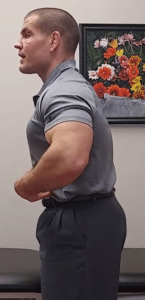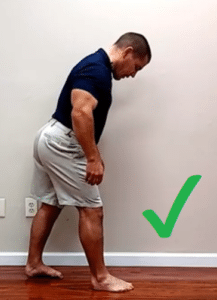Want To Learn How To Stand Longer Without Pain?
Watch this video to learn how to stand longer without pain in your back, hips, knees, or feet. Plus learn 3 stretches that help the most common problems with standing for long periods of time.
Having Pain When Standing For Long Periods Is Common
(but NOT normal)
Standing for long periods of time becomes increasingly difficult as you age.
Whether it's due to knee arthritis, hip arthritis, back pain, or plantar fasciitis - many people start having difficulty standing as they get older.
In this post, you'll learn a really simple method to help you stand longer with less pain in your back, hips, knees, and feet.
The good news is that no matter where you're experiencing pain, by following this simple method, you can decrease your pain and be able to stand longer.
Plus, at the end of the post, I'll show you 3 stretches that will help with the most common problems people face when they're standing.
Why You May Have Pain When Standing For Long Periods
The reason people have trouble standing longer as they age is that when you're in one position for long periods of time, it puts weight on the same parts of your joints.
When you're moving around and exercising, you're alternating the weight-bearing positions of your joints. However, when you're stationary in one position, the load is concentrated on the same parts of your joints.
This becomes more problematic as you age, especially if you've lost cartilage that cushions the joints.
Additionally, when you're moving, your muscles are active and changing positions, but when you're still in one position for a long time, your muscles stiffen up and become tight.
Furthermore, if your spine or legs are not in an optimal position to support you, your muscles have to work harder just to maintain your posture.
Therefore, finding a posture where you distribute equal weight on your joint surfaces, being able to change between postures, and having your spine and legs support you properly are essential for standing without pain.
How To Find Your Ideal Posture To Stand Longer Without Pain
First, I want to go through how to find your ideal standing posture.
Truthfully there is no one "ideal" posture that you should stay in all the time.
Your best posture is your next posture.
This means meaning you should continue moving and not stay stationary in the same position.
However, there are times when you have to be in one position for a while, such as when working in retail, being a hairdresser, cooking, or standing in line.
To find your ideal standing posture, start from the ground up.
1. Place your feet
Place your feet where they naturally fall, which may be with your toes pointed straight ahead, pointed outwards, or even pointed inwards.
2. Front-to-back weight shift
Move through the available range of motion leaning towards your toes and then towards your heels. Find a middle position where you're balanced and have equal weight distribution on your feet.
3. Side-to-side weight shift
Next, shift your weight from side to side, feeling the weight transfer between each foot. Again, find a balance point with equal pressure on each foot.
4. Rotate knees in and out
Moving up to your knees, bring them all the way in and then all the way out.
Then find a resting position somewhere in that feels easiest and requires the least energy to maintain.
5. Pelvic tilt
Then move up to your hips. Roll your pelvis under, which flattens your lower back and can be beneficial for spinal stenosis or degenerative disc disease.
Then arch your lower back all the way.
Finally, find a position that feels comfortable and easy to maintain.
6. Chest, shoulders, and upper back
The next position to consider is your chest and shoulder position. Lift your chest up and let your shoulders slouch, then find the position where you're most comfortable.
3 Stretches To Help You Stand Longer Without Pain
Your current posture can indicate which muscles might be tight or stiff.
The most common muscle groups that con tribute to pain when standing are your:
- calves
- hip flexors
- chest muscles
Tight calves can cause your feet to flatten when standing. This in turn causes your knees to move inward, which can cause inner knee pain.
Tight calves can also cause your lowe legs and hips to move backward.
In order to prevent falling backwards, you have to lean your trunk forwards be bending at the hips.
This, in turn, can cause tight hip flexors.
If your hip flexors are tight and you're bent forwards, most people will try to stand upright by arching their lower back.
This in turn can cause lower back pain when standing for long periods.
Chest muscles can contribute to a hunched-over posture, that rounds your upper back and shoulders.
This posture is known as kyphosis.
In order to compensate for kyphosis, many people again arch at their lower back which, again can cause back pain, especially if you have degenerative disc disease.
To address these issues, try these three stretches for your calves, hip flexors, and chest muscles.
Calf Stretch
The first stretch is for your calves.
Stagger one foot backward, keeping your heel flat on the floor and toes pointing ahead. Hold the stretch 1-2 minutes.
Move your knee over your toe, ensuring your foot doesn't flatten and your toes don't point outwards.
These are the most common mistakes people make with calf stretches.
Hip Flexor Stretch
The second stretch is for your hip flexors, which involves a similar position to the calf stretch.
In the calf stretch you keep your heel on the floor. However, in the hip flexor stretch, as you roll your pelvis underneath you, you'll notice your heel will leave the floor.
You should feel a stretch in the front of your hip and thigh.
Make sure not to arch your lower back.
Hold this position for a minute or two.
Learn other variations of a hip flexor stretch here.
Chest, shoulder, and upper back stretch
The third stretch targets the chest and shoulders.
Stand with your lower back against a wall, keeping it flat.
Lift your chest and shoulders while keeping your lower back flat on the wall.
Bring your arms in a goalpost position, and try to bring your fingertips and upper back closer to the wall.
Again, keep your lower back flat against the wall throughout the stretch.
Hold for 1-2 minutes.
Learn more chest stretches here.
Conclusion
To summarize how to stand longer without pain:
- Move forward and backward and side to side to find a neutral position on your feet.
- Find a neutral position of hip rotation by turning your knees in and out until you find a comfortable, balanced position.
- Roll your pelvis forward and backward to find a neutral position that's comfortable for your lower back.
- Lift your chest without arching your lower back excessively.
Throughout the day, aim to move between different postures, but default back to this "ideal" posture where you'll spend most of your time when standing.
Additionally, stretching your calves, hip flexors, and chest muscles can also help you stand longer without pain.
If you live in the St. Louis area and need more help to stand longer without back, hip, knee, or foot pain, tap the button below to request an appointment with one of our specialist physical therapists.









